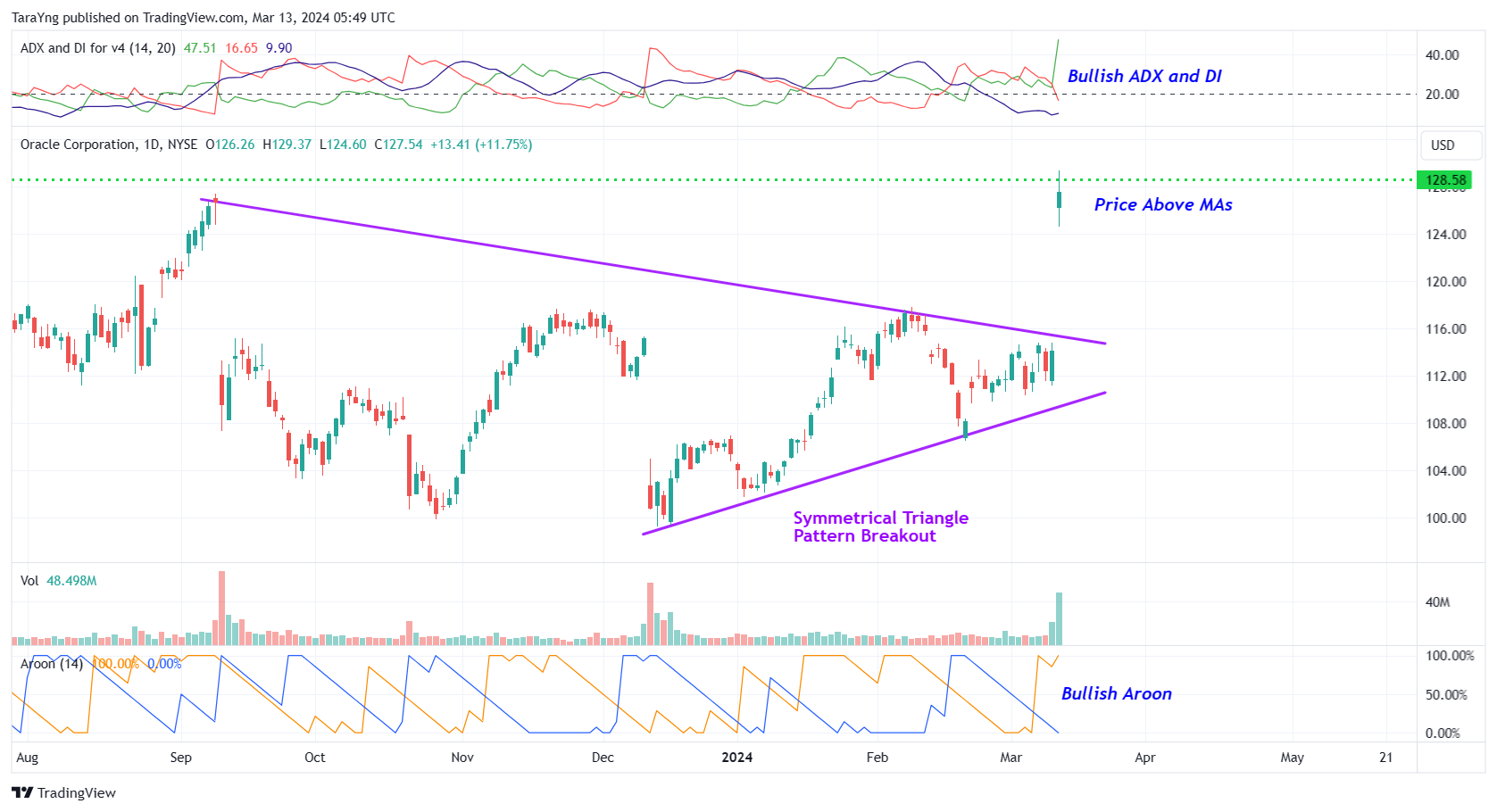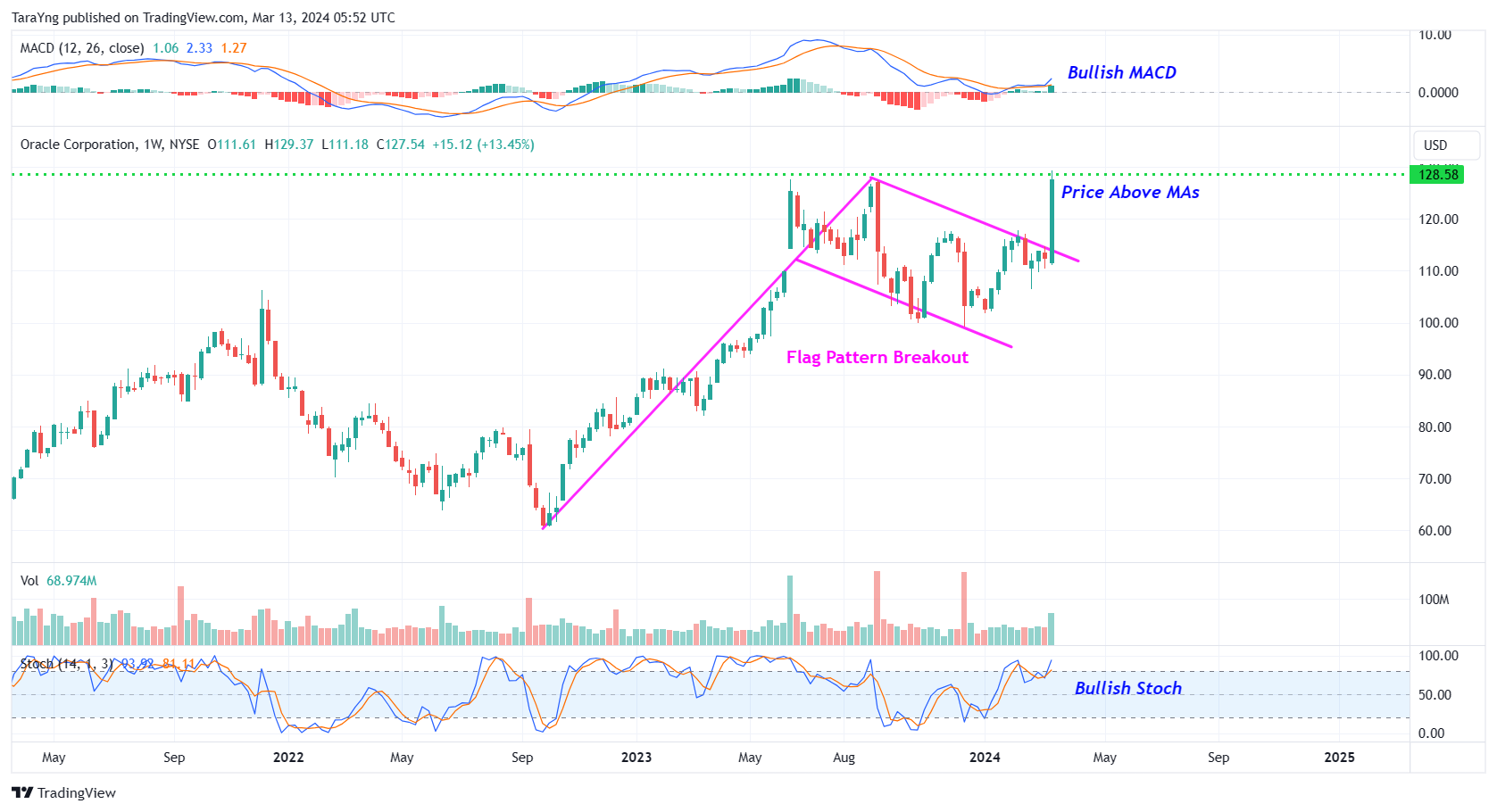Oracle Corporation (NYSE: ORCL) seems to be poised for a price surge as per its latest charts. The company offers products and services that address enterprise information technology environments worldwide.
Its Oracle cloud software as a service offering include various cloud software applications, including Oracle Fusion cloud enterprise resource planning (ERP), Oracle Fusion cloud enterprise performance management, Oracle Fusion cloud supply chain and manufacturing management, Oracle Fusion cloud human capital management, Oracle Cerner healthcare, Oracle Advertising, and NetSuite applications suite, as well as Oracle Fusion Sales, Service, and Marketing.
Bullish Indications
#1 Symmetrical Triangle Pattern Breakout: The daily chart shows that the stock had recently formed a Symmetrical Triangle pattern. This is a continuation pattern and is characterized by two converging trend lines connecting a series of sequential peaks and troughs. This pattern is marked on the daily chart as purple color lines. The breakout from a symmetrical triangle pattern usually signifies a bullish move. Currently, the stock has broken out of the symmetrical triangle pattern which is a possible bullish sign.
#2 Price above MAs: The price is currently above the short-term moving average of 50-day SMA as well as the longer-term moving average of 200-day SMA, indicating that the bulls are still in control. This is a positive indication.
#3 Bullish ADX: The ADX indicator shows that the +DI line is currently above the –DI line and the ADX line has started to move up from below the –DI and +DI lines. This indicates possible bullishness.
#4 Bullish Aroon: The value of Aroon Up (orange line) is above 70 while Aroon Down (blue line) is below 30 in the daily chart. This indicates possible bullishness.
#5 Flag Pattern Breakout: The weekly chart shows that the stock was in an uptrend after which it started consolidating and was in a narrow range. This is a classic flag pattern and is marked in the chart in pink color. Currently, the stock has broken out of the flag. A Flag is a continuation pattern. Whenever a stock breaks out of the flag pattern, it typically continues its previous trend (uptrend in this case). The stock is also trading above its 50-week and 200-week SMA. All these are possible bullish indications.
#6 %K above %D: The %K (blue) line of stochastic has currently crossed above the %D (Orange) line in the weekly chart. This is a possible bullish indication.
#7 Bullish MACD: The MACD line is above the MACD signal line in the weekly chart indicating bullishness.
Recommended Trade (based on the charts)
Buy Levels: If you want to get in on this trade, you can purchase shares of ORCL above the price of around $128.60.
TP: Our target prices are $135 and $140 in the next 3-6 months.
SL: To limit risk, place stop-loss at $125.00. Note that the stop-loss is on a closing basis.
Our target potential upside is 5% to 9% in the next 3 to 6 months.
For a risk of $3.60, our target rewards are $6.40 and $11.40. This is a nearly 1:2 and 1:3 risk-reward trade.
In other words, this trade offers nearly 2x to 3x more potential upside than downside.
Risks to Consider
The stock may reverse its overall trend if it breaks down from the symmetrical triangle pattern breakout level with a high volume. The sell-off of the stock could also be triggered in case of any negative news, overall weakness in the market, or any regulatory changes in the sector.
Happy Trading!
Tara
MAG-7 Stocks Are Dead—Here's What Killed Them [sponsor]The old way of investing in tech giants is over. A NEW strategy unlocks 146X more income on the SAME underlying stocks (like Meta, Apple, and Amazon) -- WITHOUT options trading. Click here to uncover the NEW MAG-7 alternative.
Source: Trades of the Day



